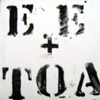 E.E and The Owl Archimedes love dancing to death... literally. Adoringly these two sculptors have put one of the world's most-revered tunes to the chopping block and, by virtue of its eradication, developed a new spectrum of radiant sounds and mutant un-rhythms to enjoy. This is a requiem for the dancing queen, who in death sounds as marvelous as she did in life.
E.E and The Owl Archimedes love dancing to death... literally. Adoringly these two sculptors have put one of the world's most-revered tunes to the chopping block and, by virtue of its eradication, developed a new spectrum of radiant sounds and mutant un-rhythms to enjoy. This is a requiem for the dancing queen, who in death sounds as marvelous as she did in life.
Wise Owl
There is a theory that one thing is simply the parody of another thing. The Greek word from which we get the English "parody" literally means "beside or parallel to a song or ode." Stretch that definition out a bit and some very interesting things can happen with parodies: crime could "stand side by side" with sex or wealth could be made a parallel of poverty. This may not seem particularly original or innovative, but the upshot is that a parody can cast new light on something for better or for worse. Parody can reveal what originally captivated us about our favorite records in surprising ways or it can amplify the repulsive in something and give us pause for reconsidering it. E.E and The Owl Archimedes have clearly spent some time with ABBA's "Dancing Queen" and their love for the song is evident through every second of their double-CD tribute to it. This is by no means a remix project, however; The End of Deconstruction is a loving parody of ABBA's dance-floor machinations. It is composed of four entirely unique ambient-noise pieces, each developing slowly and with a somber tone, suggesting the slow march of a funeral procession. The bright and energetic life of "Dancing Queen" is thus transformed into a dark meditation on what happens when the music decays and the happy veneer of pop-beauty fades.
The irony is that the beauty of the song doesn't really fade during the parodic transformation, but is replaced by an attractiveness of a different kind. The first disc begins with E.E's "Venus." It presents itself delicately at first, slowly growing into a constant and voluminous hum. Bits of stereo debris bubble to surface over the course of the song lending it only the most microscopic variation . "Venus" does away with time or alters it; lasting more than 19 minutes it swallows up more than a quarter of an hour quietly and surprisingly. Its all-encompassing flow sets everything into drift and seduces by its simplicity. When that monumental tone is silenced a sense of loneliness is all that's left in its wake and every other minute sound, from the moaning of a loose board to the uneven drop of a leaky faucet, becomes as loud and intrusive as an unexpected car horn. "Birth," on the other hand, takes the opposite approach. It begins in deceptive silence and then crescendos quickly, the familiar sounds of "Dancing Queen" almost recognizable through the slow distortion and patterned, tessellated noise. It's a clumsy piece to be sure, nakedly revealing portions of the song and unfurling like a cut and scored digital tapestry. Nevertheless, it inspires both laughter and appreciation; it is absolutely ridiculous that the song should be made to contort this way, but it's also amazing that the original lends itself so perfectly to these degenerative processes.
E.E's "Liminal State" begins the second disc and supplements "Birth." Here, all the pretzeled twists and turns of "Birth" are transformed into a backing band and a choir of voices are brought to center stage. What was a noise piece is transformed into an orchestral explosion of grandiose proportions. Though the song is filled with colliding sounds from beginning to end there is a sense of space present in the work; as a result the undulating of various component noises feels more peaceful and relaxed than busy and tense. It's a delicate balance that he strikes between distress and calm and he keeps that balance interesting for over half an hour. It stands out as the best composition on the album. That's not to take away from The Owl Archimedes' concluding contribution, "Lost Memories." This seems to be a supplement to E.E.'s "Venus" as it adds a great deal of depth to that ascetic and severe drone. Like that opening song it is almost unidentifiable as a reworking of "Dancing Queen." Replacing the stereo hiccups are a series of digital horns that scream and stretch throughout the song. As the piece develops various dial tones begin to populate the work almost as though they are vying for attention with those horns. This competition comes to a frenzied head about halfway through and then the intensity subsides and the album ends in a simple and lovely drone.
The End of Deconstruction comes in a hand-made double-CD package with a small but classy insert and is also numbered. Only 40 copies were made originally, some of which may still be available but will likely be gone soon. The record label has also made the music available for free through their website by way of MP3s. This may be a parody, but the artists involved couldn't have taken the project more seriously; it shows in both the music and the presentation.
samples:

